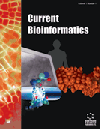- Home
- A-Z Publications
- Current Bioinformatics
- Previous Issues
- Volume 18, Issue 1, 2023
Current Bioinformatics - Volume 18, Issue 1, 2023
Volume 18, Issue 1, 2023
-
-
Comparison of Gene Selection Methods for Clustering Single-cell RNA-seq Data
More LessAuthors: Xiaoshu Zhu, Jianxin Wang, Rongruan Li and Xiaoqing PengBackground: In single-cell RNA-seq data, clustering methods are employed to identify cell types to understand cell-differentiation and development. Because clustering methods are sensitive to the high dimensionality of single-cell RNA-seq data, one effective solution is to select a subset of genes in order to reduce the dimensionality. Numerous methods, with different underlying assumptions, have been proposed for choosing a su Read More
-
-
-
i4mC-CPXG: A Computational Model for Identifying DNA N4- methylcytosine Sites in Rosaceae Genome Using Novel Encoding Strategy
More LessAuthors: Lichao Zhang, Ying Liang, Kang Xiao and Liang KongBackground: N4-methylcytosine (4mC) is one of the most widespread DNA methylation modifications, which plays an important role in DNA replication and repair, epigenetic inheritance, gene expression levels and regulation of transcription. Although biological experiments can identify potential 4mC modification sites, they are limited due to the experimental environment and labor intensive. Therefore, it is crucial to co Read More
-
-
-
M-CAMPTM: A Cloud-based Web Platform with a Novel Approach for Species-level Classification of 16S rRNA Microbiome Sequences
More LessBackground: The M-CAMPTM (Microbiome Computational Analysis for Multi-omic Profiling) Cloud Platform was designed to provide users with an easy-to-use web interface to access best in class microbiome analysis tools. This interface allows bench scientists to conduct bioinformatic analysis on their samples and then download publication-ready graphics and reports. Objective: In this study, we aim to describe the M-CAMPTM Read More
-
-
-
Comprehensive Pan-cancer Gene Signature Assessment through the Implementation of a Cascade Machine Learning System
More LessBackground: Despite all the medical advances introduced for personalized patient treatment and the research supported in search of genetic patterns inherent to the occurrence of its different manifestations on the human being, the unequivocal and effective treatment of cancer, unfortunately, remains as an unresolved challenge within the scientific panorama. Until a universal solution for its control is achieved, ea Read More
-
-
-
Hypertension Risk Prediction Based on SNPs by Machine Learning Models
More LessAuthors: S. A. Lajevardi, Mehrdad Kargari, Maryam S. Daneshpour and Mahdi AkbarzadehBackground: Hypertension is one of the most significant underlying ailments of cardiovascular disease; hence, methods that can accurately reveal the risk of hypertension at an early age are essential. Also, one of the most critical personal health objectives is to improve disease prediction accuracy by examining genetic variants. Objective: Therefore, various clinical and genetically based methods are used to predict the dis Read More
-
-
-
TMMGdb - Tumor Metastasis Mechanism-associated Gene Database
More LessAuthors: Hsueh-Chuan Liu, Ka-Lok Ng, Venugopala R. Mekala and Chien-Hung HuangBackground: At present, all or the majority of published databases report metastasis genes based on the concept of using cancer types or hallmarks of cancer/metastasis. Since tumor metastasis is a dynamic process involving many cellular and molecular processes, those databases cannot provide information on the sequential relations and cellular and molecular mechanisms among different metastasis stages. Obje Read More
-
-
-
Characterization, Potential Prognostic Value, and Immune Heterogeneity of Cathepsin C in Diffuse Glioma
More LessAuthors: Quanwei Zhou, Shasha Li, Xuejun Yan, Hecheng Zhu, Weidong Liu, Youwei Guo, Hongjuan Xu, Wen Yin, Xuewen Li, Qian Yang, Hui Liu, Xingjun Jiang and Caiping RenBackground: Diffuse glioma is the most frequent intracranial tumor and remains universally lethal. Prognostic biomarkers have remained a focus in diffuse glioma during the last decades. More reliable predictors to adequately characterize the prognosis of diffuse glioma are essential. Cathepsin C (CTSC), a lysosomal cysteine protease, is an essential component of the lysosomal hydrolase family, with their potential roles in diffuse Read More
-
-
-
DHOSGR: lncRNA-disease Association Prediction Based on Decay High-order Similarity and Graph-regularized Matrix Completion
More LessAuthors: Guobo Xie, Zelin Jiang, Zhiyi Lin, Guosheng Gu, Yuping Sun, Qing Su, Ji Cui and Huizhe ZhangBackground: It has been shown in numerous recent studies that long non-coding RNAs (lncRNAs) play a vital role in the regulation of various biological processes, as well as serve as a basis for understanding the causes of human illnesses. Thus, many researchers have developed matrix completion approaches to infer lncRNA–disease connections and enhance prediction performance by using similarity information. Objec Read More
-
Volumes & issues
-
Volume 20 (2025)
-
Volume 19 (2024)
-
Volume 18 (2023)
-
Volume 17 (2022)
-
Volume 16 (2021)
-
Volume 15 (2020)
-
Volume 14 (2019)
-
Volume 13 (2018)
-
Volume 12 (2017)
-
Volume 11 (2016)
-
Volume 10 (2015)
-
Volume 9 (2014)
-
Volume 8 (2013)
-
Volume 7 (2012)
-
Volume 6 (2011)
-
Volume 5 (2010)
-
Volume 4 (2009)
-
Volume 3 (2008)
-
Volume 2 (2007)
-
Volume 1 (2006)
Most Read This Month
Article
content/journals/cbio
Journal
10
5
false
en


